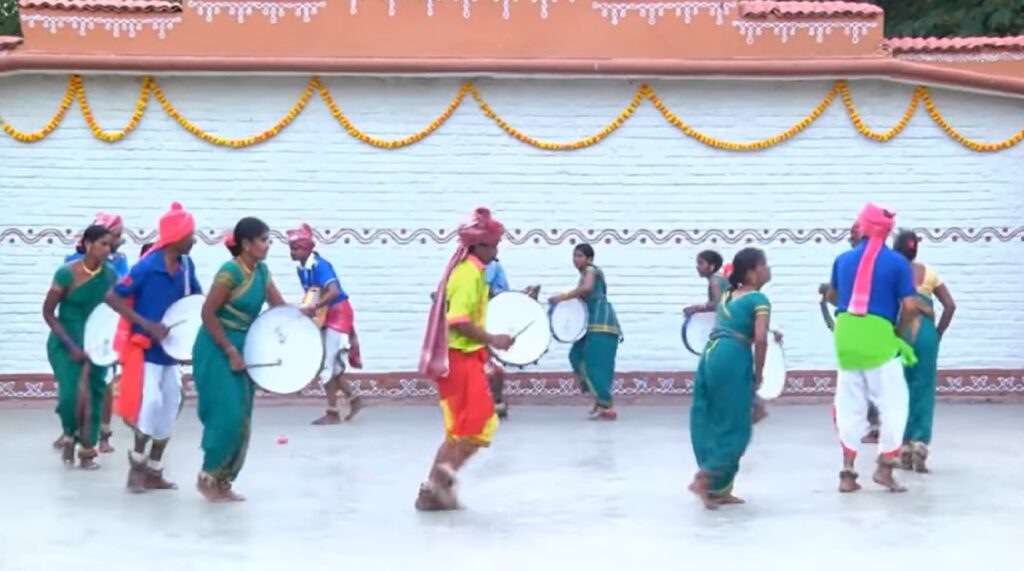Andhra Pradesh has brought so many folk dances in Indian culture. Dappunruthyam or Dappu is one of them. Dappu dance is proof that to enjoy music and dance you do not necessarily need to have expensive instruments or uptight performance. This is a dance that goes with the beat of the drums and people dance on it with their hearts.

Dappu dance form is mainly celebrated in the Nizamabad District of Telangana. These dancers can be seen everywhere whenever there is an event that requires free spirit and enthusiasm.
Dappu Dance Story
There is a story told in many villages of Telangana and Madhya Pradesh. It is said that there was a man who went to the jungle to hunt. When he reached in Jungle he saw two monkeys one male and another female sitting with each other. The male monkey was beating a flat drum and the female monkey was listening to it.
The man wanted to hunt and he tried to aim at the male monkey since it was forbidden to kill the female monkey. When he aimed at the male monkey he accidentally killed the female. After it, the male monkey did everything in his power to revive his partner but all efforts were in vain. He also beat the drum thinking she will live again. When the male monkey lost all hopes he mourned for the death of his partner.
After seeing this, the man took the drum to the village and told them what has happened. He played the drum and its beats were so powerful that villagers started to move their bodies with it. Later on, it became a dance and future generations continued to follow it.
What is Dappu?
Dappu is an instrument from which this dance has derived its name. It has different names in different places tapetta, Thappu/Parai, and Daff. This instrument is made of leather that can be made of cows, goats, or buffalos. Dappu dance is mainly done when this drum is beaten up using sticks. The sticks that are used to beat this instrument are different in thickness.
One is thinner than another one so that it makes a different sound when it hits the drum. The thicker stick is called sirre that is held in the right hand and the thinner stick is called sitikena or chitikena held in the left hand.
For different occasions, the drum-beating style is different which is called “debba”. Sound of this drum is not soothing to ears like other musical instruments but if you are in high spirits and witnessing the dance then you will surely be amazed by this dance form.
The beating of the Dappu is not freestyle. It follows rhythm and styles. Where sometimes it is done in celebration other times it is done based on mythological themes to teach people and entertain them.
Development of Dappu
Dappu’s roots can be found in the villages of Andhra and Telangana. In the beginning, it was only an instrument to get people’s attention. Remember the drums which raja’s employees used to beat when they were making an announcement? Yes, Dappu is one of those drums. The only difference is that the beating up of this drum developed into something musical and people started including it in their celebrations. This did not happen in one day, it took years and generations for this to become a dance.
Dappu Dancers
Dappu is danced is a group of fifteen to twenty people. Only males participate in this dance. Females can be included only in the celebratory dance. For different occasions, dance styles differ a little. For example, when the dance is being performed at stage dancers move in a circular motion and when it is being performed on roads it is performed while moving forward.
Costume of Dappu Dance
Dancers wear a turban that is called tala paga, a dhoti (bottom), and bells on their ankle. These are the bells that make dance more pleasing by rhyming with the drum beats. Costumes of dancers are very colorful and they use colorful makeup too.
Instruments used in Dappu Dance
- Tabla
- Cymbals
- Harmonium
- Dapppu
Leatherworkers are the ones who started dancing and playing this drum for their amusement as upper caste people did not allow them to be included in their events. Dappu is not only a drum on which people dance it signifies so many things. It became a movement for the Madiga community.

Pingback: Folk Dances of India - Auchitya
Pingback: All Folk Dances of India - Auchitya
Pingback: Dhimsa Dance of the Porja Tribe - Auchitya
Pingback: Dhimsa Dance of the Porja Tribe of Andhra Pradesh - Auchitya
Pingback: All Folk Dances of India - Statewise Complete List - Auchitya